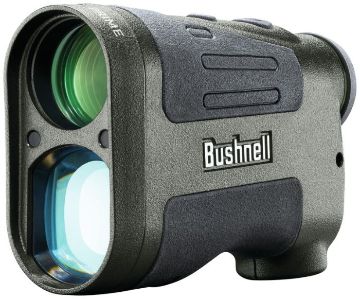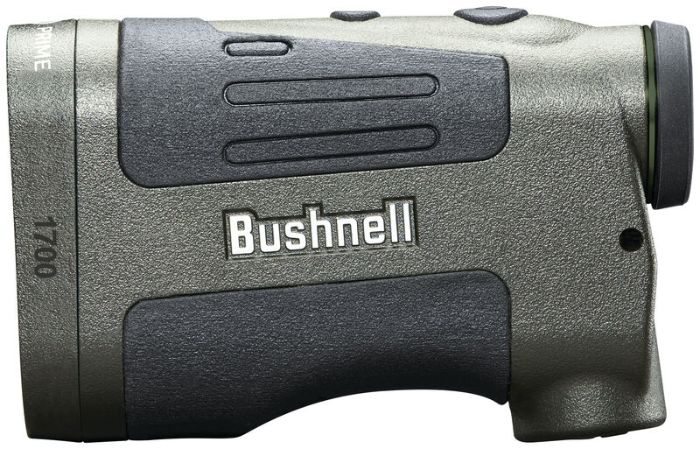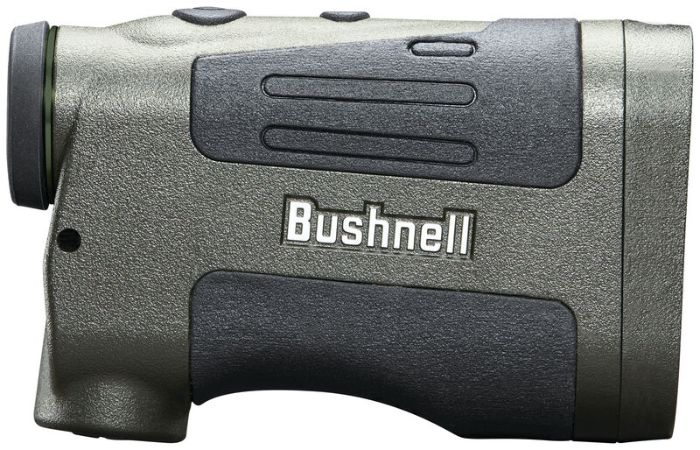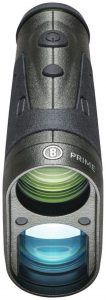It looks like the Bushnell Prime rangefinders saw an overhaul not long after they were released to market as a new series.
Now, they’re packed with additional features without a significant cost increase.
The big boy of the series is the 1700 with ARC and built-in ballistics to provide adjustment values, has selectable reticles, and multiple target modes.
Yes – this advanced rangefinder is under $300.
Could the Prime 1700 be the new standard for this price point?
Quick Overview...
What We Like: Prime 1700 noteworthy features
What We Don’t Like: Glass gripes
Best Uses: Hunting, Bow Hunting, Target Shooting, Angle Compensation, 1-Mile Range
- Yard Range: 5-1700
- Magnification: 6x
- Objective Lens: 24mm
- Display Type: LCD
- Dimensions: 4.27 x 1.47 x 2.75”/5.9 oz
- Waterproof/Fogproof: Yes
- Angle Compensation: Yes

Our Verdict: Combining the feature-packed platform of the Bushnell Prime 1700 and a low price point is a recipe for success. For one of the cheapest rangefinders with max capability and real glass optics, it stands peerless.
Who is the Bushnell Prime 1700 Best Suited to?
The Prime 1700 is one of those rangefinders that is suitable to all hunters and shooters. It may have less ranging than some impressive 4000 and 5000-yard units available today, but it’s also a lot cheaper and compact.
With Bow and Rifle modes, it provides true horizontal distances and ballistics based on pre-selected load combos. With the 1700-yard max range, it’s a great rangefinder for target shooting and matches. There isn’t much you can’t do with the Prime.
How Does the Bushnell Prime 1700 Perform?
For a $200 rangefinder, you can bet that the Prime 1700 has instant status when it sports angle compensation, rifle ballistics, readings in MOA or MIL, and multiple target modes. This kind of complexity in a rangefinding unit is just not seen at this price point.
To top things off, it has a 1700-yard maximum ranging distance and 700-yard range on deer. It’s more than long-ranging enough for most bench rest shooters, firearms trainers, rifle hunters, bow hunters, and more. It’s also not uncommon to find that it may shoot further than what Bushnell claims.
There are a few cutbacks that make it price appropriate and that includes the lack of illumination, tripod threading, and low 6x magnification. They are not deal breakers as the 6x power works well with free-hand use, and it does have a slightly larger exit pupil than most other rangefinders.
The lack of an LED display helps to keep cost down and instead bring ballistics, equivalent horizontal range benefits, and more to the table.
For the money, the 1700 can’t be bested, however if you love the Bushnell brand you might also want to take a look at the Bushnell Nitro 1800 rangefinder.
Features & Benefits

Prime 1300 Noteworthy Features
The display is not illuminated, so it does not have the red adjustable or ambient-controlled glow that we all love for daylight bright and low-light visibility. However, to keep costs down, the Prime has a Vivid LCD display.
You can sharpen the image with the adjustable diopter, but you can’t adjust the eyecup itself for eye relief. It’s pretty much a stick-it-to-your-eye and range-with-it type of unit - simple enough.
What is especially noteworthy at this price point are the selectable reticles of which there are three: Circle, Dot, and Circle with Dot. The latter is the default reticle, but you can use any of them with any of the modes you wish to range with.
The unit has a 2-button interface with one for mode/settings and the other for fire/confirmations. While we like projecting buttons that make it easy to find without having to leave your sight, but button operation for complex menus requires a lot of toggling/scrolling.
For today’s feature-packed units, some sort of dial or wheel could be a worthwhile menu navigation convenience. Check out the Maven RF.1 to see what we mean.
Multiple Ranging Modes
The Prime series of rangefinders have always had ARC (Angle Range Compensation), but what’s new are the Bow and Rifle modes under ARC. Of course, you still have a Regular mode that provides only the line-of-sight distance.
Bow Mode is rather simple to understand as it provides a true horizontal distance in relation to the angle of the bow hunter. The display provides the LOS distance in the center with the incline/decline angle to the left and the angle compensated distance at the bottom center of the field of view. This is usually all that is needed from a rangefinder for bow hunting – done and done.
In Rifle Mode, things get a lot more complex. The Prime 1700 is capable of providing the shooter with adjustments in either inches, centimeters, MOA, or MIL. The adjustment values are calculated based on algorithms that take into account, LOS distance, angle, and ballistics.
When it comes to adjustment value formats (holdover/bullet drop), the unit will default to inches if you’re in yards and centimeters if you’re in meters based on the measuring system you choose during setup. You can also opt for value formats in MOA or MIL.
The unit has preloaded combinations of calibers and loads categorized into eight groups from A-H. They also have two groups to cater to muzzleloaders (I & J). The Bushnell website and PDF ballistic chart provides 2000 combos, so if you’re unsure about your setup, check it out.
Once you’ve completed Rifle mode setup, the display will have the LOS distance, incline/decline angle, and holdover/bullet drop reading in the format that you’ve selected.
Multiple Target Modes

The Prime rangefinder offers three modes: Standard, BullsEye, and Brush, all of which are compatible with Scan at any time.
Standard is the default mode and is used for medium-reflective targets from 4-1700 yards. BullsEye is the unit’s first target mode that picks up on small targets in the foreground and displays the closest distance.
Brush mode is the unit’s second target mode that picks up distances on targets in the background obscured by brush, trees, and other obstructions. When the beam divergence picks up multiple targets, it will display the distance of the furthest target.
Laser Ranging Accuracy
The Prime is a great example of how advertised ranges are not the same as non-reflective ranges. The 1700 is named for its max performance on high reflective targets out to 1700 yards. On trees, it ranges to 1000 yards and on deer to 700 yards.
You must appreciate the transparency as it provides you with the expected data upfront. 700 yards is still a long way off for deer, and for a rangefinder that costs less than $200, it’s a performer.
The laser ranges up to four times per second in Scan mode and is accurate to within +/-1-yard from 5 yards to max ranging distance.
Compact Pocket Unit

The Prime 1700 is one of the smallest rangefinders out there. It’s only 4.2” long and 6 oz (approximates) in weight. It’s a true pocket-size rangefinder.
While compact and mini, it’s still tough and is water-resistant with an IPX4 rating. There is a noticeable difference between the old Primes and these new ones from its finish to its ergonomic curves.
The interesting protrusion on the underside of the unit is the battery compartment that helps to provide stable and more comfortable hand gripping. If you were hoping it was tripod mount, it’s not.
With 6x magnification, it’s well suited to ranging free-hand even at distances of one mile.
Limitations
Glass Gripes
At this price point and from Bushnell, we fully expect glass lenses – zero plastic! This is the case, and Bushnell does provide fully multi-coated coatings to all air-to-surfaces and tops off the exterior lens with the EXO coating for a smudge-free, water, oil, and dust repelling treatment.
To claim 2x brighter transmission and 40% larger objective lenses would have more credibility if we knew what this is in comparison to. The previous Prime rangefinders also had 20 and 24mm lenses, so it could be in comparison to 15mm objective apertures of the past or current 15mm alternatives by other manufacturers.
Popular Questions
The Prime 1700 is covered under the Ironclad Lifetime Warranty. The catch is, the electronics are not covered, so there are some obvious limitations to how far you can take advantage of repair/replacement coverage.
Bushnell has golf specific rangefinders, but if you’re looking for a unit that can be used for both hunting and golf, the Prime 1700 will do the job, although it will be overkill for golf.
It has BullsEye mode that operates in first target mode that will allow you to hit the pin. You can also range in the other modes to get angle compensation, distances to bunkers and the trees, get on the green, etc.
The Bushnell Prime 1700 comes with a carry case, lanyard tether, paracord, Quick Start Guide, and instruction sheet in the box.
No, you must power the Prime 1700 with a CR2 battery. Without a power source, the unit will operate as a 6x monocular with no display and laser electronics.
Conclusion
Besides maybe an LED display, there is little justification to feel left wanting with the Prime rangefinder. It’s an advanced unit for its price point and has excellent specs for true handheld ranging at max distance.
With the multiple types of coded algorithms for ranging and targeting, it’s ideal for new hunting grounds or mountainous, unpredictable terrain. Using the same unit for bow hunts, muzzleloader hunts, matches, target shooting, and golf, it’s a rangefinder that can do it all at half the cost.
The Prime is a winning rangefinder for any buyer on a budget.
Further Reading




